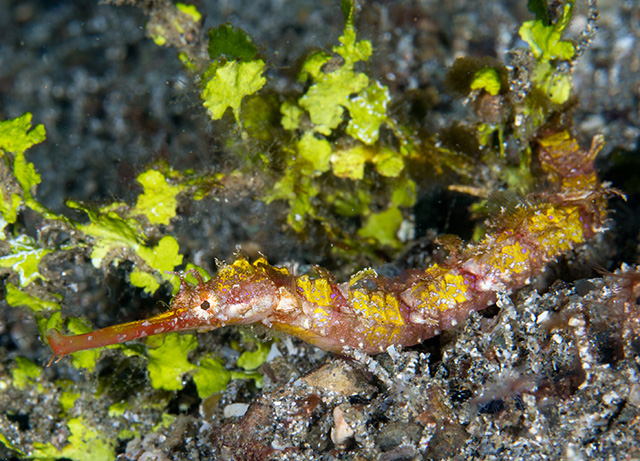| Syngnathidae (Pipefishes and seahorses), subfamily: Syngnathinae |
| 18 cm TL (male/unsexed) |
|
reef-associated; marine; depth range 3 - 25 m |
| Indo-West Pacific: northern Red Sea (Gulfs of Suez and Aqaba), Indonesia off Sumbawa Islands, Queensland in Australia, Port Moresby in Papua New Guinea, New Britain Islands and Guadalcanal Islands in the Solomon Islands. |
|
Dorsal spines (total): 0-0; Dorsal soft rays (total): 18-19; Anal soft rays: 4-4. Superior trunk and tail ridges discontinuous; inferior trunk ridge ending at anal ring; lateral trunk ridge continuous with inferior tail ridge; body rings 14 or 15 + 25-25. Colors vary with habitat, colorful on algae-rubble and dull on sand (Ref. 48635).
Description: Characterized by having variable color, usually shades of red, green or brown with pale blotches; 10 caudal rays; discontinuous superior trunk and tail ridges; inferior trunk ridge ends at anal ring; irregular minute spines on median dorsal snout ridge; head and body with large dermal flaps (exaggerated in juvenile); length of snout 1.5-1.8 in head length; depth of snout 9.2-16.0 in snout length; head length 4.7-5.1 in SL (Ref. 90102). |
| Adults inhabit reef flats where it is found in seagrass areas, among coral rubble and algae-covered rocks. Juveniles occur with round-leafed seagrasses on sand slopes, usually settling from pelagic state at about 8 cm long. Adults on sand or algae covered reefs to about 25 m depth (Ref. 48635). Ovoviviparous (Ref. 205). The male carries the eggs in a brood pouch which is found under the tail (Ref. 205). Solitary or in pairs (Ref 90102). |
|
Least Concern (LC); Date assessed: 04 December 2015 Ref. (130435)
|
| harmless |
Source and more info: www.fishbase.org. For personal, classroom, and other internal use only. Not for publication.

